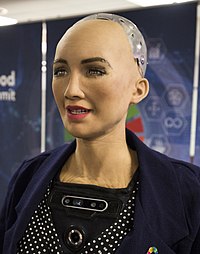Robot humanoide




Un robot humanoide es un robot diseñado para imitar o simular la forma y los movimientos de un ser humano.
Un diseño humanoide puede tener fines funcionales, tales como la interacción con herramientas y entornos humanos, con motivos experimentales, como el estudio de la locomoción bípeda, o para otros fines. En general, los robots humanoides tienen un torso, una cabeza, dos brazos y dos piernas, aunque algunas formas de robots humanoides pueden modelar sólo una parte del cuerpo, por ejemplo, de cintura arriba. Algunos robots humanoides pueden tener cabezas diseñadas para replicar los rasgos faciales humanos, tales como los ojos y la boca. Los androides son robots humanoides construidos para parecerse estéticamente a los humanos. Los robots humanoides actualmente son usados como herramienta en investigaciones científicas.
Véase también
[editar]Referencias
[editar]- ↑ «A Ping-Pong-Playing Terminator». Popular Science.
- ↑ «Best robot 2009». www.neterion.com. Archivado desde el original el 24 de julio de 2010.
Bibliografía
[editar]- Carpenter, J., Davis, J., Erwin‐Stewart, N., Lee. T., Bransford, J. & Vye, N. (2009). Gender representation in humanoid robots for domestic use. International Journal of Social Robotics (special issue). 1 (3), 261‐265.The Netherlands: Springer.
- Carpenter, J., Davis, J., Erwin‐Stewart, N., Lee. T., Bransford, J. & Vye, N. (2008). Invisible machinery in function, not form: User expectations of a domestic humanoid robot. Proceedings of 6th conference on Design and Emotion. Hong Kong, China.
- Williams, Karl P. (2004). Build Your Own Human Robots: 6 Amazing and Affordable Projects. McGraw-Hill/TAB Electronics. ISBN 0-07-142274-9. ISBN 978-0-07-142274-1.
Enlaces externos
[editar] Wikimedia Commons alberga una categoría multimedia sobre Robot humanoide.
Wikimedia Commons alberga una categoría multimedia sobre Robot humanoide.- MIT Media Lab Personal Robots Group
- Humanoid Robots' jobs in Japan
- MIT Lab Research Projects
- Ethics for the Robot Age